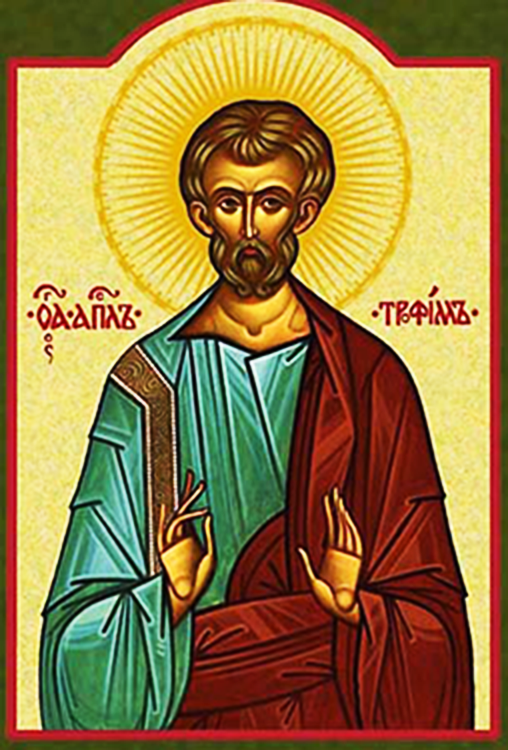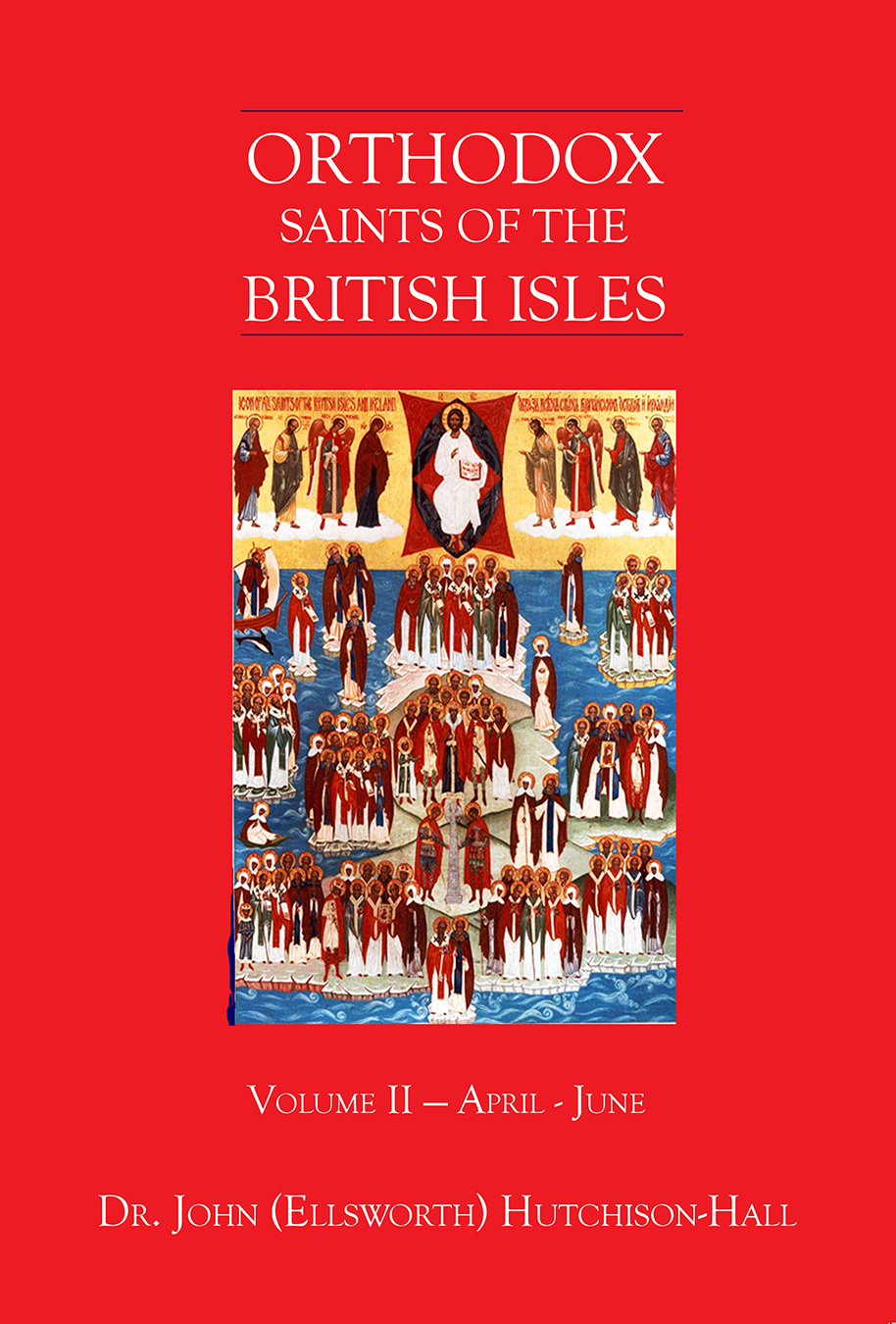
Orthodox Saints of the Pre-Schism
See of Rome
12th May (NS) — 29th April (OS) 2023
AGAPIUS and COMPANIONS (MARTYRS of CIRTA), a group of clergy and laity martyred in Cirta in Numidia (present-day Tunisia), during the persecutions under Emperor Valerian (r. 253–260). According to the Roman Martyrology those martyred with St. Agapius were: Antonia, Emilian, Secundinus, Tertula, and a woman and twin children whose names are no longer known.
AVA (AVIA) of DENAIN, a niece of Pepin the Short, King of the Franks (r. 751–768), who was miraculously healed by St. Rainfrede (8th October) of blindness which she had suffered since childhood. In time St. Ava, received monastic tonsure at Denain Abbey in Hainaut, present-day Belgium, and later served as its Abbess. St. Ava reposed circa 845.
DANIEL of GERONA, (Ninth Century), according to a legend of suspect veracity, St. Daniel was native of Asia Minor who became a hermit at an unknown location in present-day Spain. He is listed as a martyr, though the circumstances and location of his martyrdom are unknown.
DICHU (DICTINUS), (Fifth Century), St. Patrick's (17th March) first convert in Ireland, St. Dichu was the son of an Irish chieftain and a swineherd in his youth. He gave St. Patrick the land at Saul in Co. Down, Ireland for his first church.
ENDELLION (ENDELIENT, ENDELIENDA) of TREGONY, (Sixth Century?), St. Endellion was one of the daughters of St. Brychan of Brycheiniog (6th April) and sister of St. Nectan (17th June). According to legend she was the Goddaughter of King Arthur. St. Endellion lived as an anchorite in Cornwall, England and is commemorated by the church and village of St. Endellion in northern Cornwall, England.
FIACHAN (FIANCHNE) of LISMORE, (Seventh Century) , St. Fiachan was a monk under St. Carthage the Younger (14th May) at the famous Lismore Abbey in Co. Waterford, Ireland. He is especially remembered for his obedience and gift of prayer.
GUNDEBERT of GUMBER, (Eighth Century), the husband of St. Bertha (1st May) and brother of St. Nivard (1st September). Towards the end of his life, St. Gundebert separated from St. Bertha by mutual consent. He then went to Ireland where he received monastic tonsure. St. Gundebert met his martyrdom when his monastery was sacked by pagans, and he was killed.
PAULINUS of BRESCIA, a sixth century Bishop of Brescia in the northern Italian region of Lombardy. Consecrated circa 524, St. Paulinus served the See until his repose in 545.
SENAN of WALES, (Seventh Century), St. Senan was a hermit in northern Wales about whom there is no information extant.
SEVERUS of NAPLES, an early fifth century Bishop of Naples (Italy). A renowned wonderworker, St. Severus once brought a man back to life, so he could testify on behalf of his wife who was facing unfounded charges. St. Severus reposed in 409.
TORPES of PISA, although the subject of many early Lives, which are almost complete devoid of fact, little is actually known of St. Torpes. As far as is known he was martyred in Pisa, circa 65, during Emperor Nero's (r. 54–68) persecution of Christians. The town of Saint-Tropez in France is named for him.
WILFRID the YOUNGER, after receiving his education at Whitby Abbey in North Yorkshire, England, under St. Hilda (17th November), St. Wilfrid attached himself to St. John of Beverley (7th May). He later succeeded St. John as the last Bishop of York, England, as the See was elevated to an archbishopric during the time of his successor. St. Wilfrid resigned the See in 732, retiring to Ripon Abbey in North Yorkshire, England where he lived until his repose in 744. He was buried at Ripon Abbey, though it is possible his relics were later translated to Canterbury, England in the mistaken belief they were those of his more famous namesake (12th November).
Get your copy of Orthodox Saints of the British Isles today.
Available at Amazon or your favourite e-bookstore.
ÆTHELHEARD (ETHELHARD) of CANTERBURY, St. Æthelhard was the fourteenth Archbishop of Canterbury. Little reliable information about his early life exists. It seems that St. Æthelheard was a native of Louth in Lindsey (present-day Lincolnshire), England and entered the monastery there, becoming Abbot before being consecrated Bishop of Winchester. He served that See of Winchester until 793 when he was elevated to Canterbury. His time as Archbishop was one of political upheaval as Offa, King of Mercia (r. 757–796) was attempting to bring the church under his secular control, very much in imitation of Charlemagne, King of the Franks (r. 768–814) on the Continent. St. Æthelhard reposed in 805.
DIOMMA of KILDIMO, (Fifth Century), St. Diomma is the patron saint of Kildimo in Co. Limerick, Ireland and was the teacher of St. Déclán of Ardmore (24th July) amongst others. Nothing further is known about him.
DIONYSIUS of ASIA, uncle, and guardian of St. Pancras of Rome (vide infra), pagans who travelled from their native Asia-Minor to Rome. Shortly after they arrived in Rome in 304, they were baptised and soon martyred for their faith during the Diocletianic Persecution.
FLAVIA DOMITILLA, EUPHROSYNA, and THEODORA of TERRACINA, (Second Century), St. Flavia Domitilla, a member of the Roman aristocracy. The details are vague and at time somewhat contradictory, however it is almost certain that St. Flavia Domitilla was a granddaughter and/or niece of several emperors, and married to the nephew of one as well. She was banished by her great-uncle Emperor Domitian (r. 81–96) to the Island of Pontia (present-day Ponza, Italy) for being a Christian, there she converted her foster sisters SS. Euphrosyna and Theodora. All three were most likely martyred by being burnt alive at Terracina south-east of Rome.
MODOALD of TRIER, a courtier at the Court of Dagobert I, King of Neustria and Burgundy (France) (r. 629–639). St. Modoald was consecrated thirty-first Bishop of Trier in 622. One of St. Modoald’s greatest achievements while Bishop was getting King Dagobert to abandon his life of intemperance, repent, and spend the rest of his life as a devout Christian. St. Modoald reposed in 640. He was originally buried in the church of the Abbey of St. Symphorian (abbaye Saint-Symphorien d'Autun) at Autun in Burgundy (France). In the early twelfth century some or all of his relics were translated to the Diocese of Paderborn where they were enshrined at the Abbey of SS. Mary, Peter the Apostle, and Modoaldus (Kloster Maria und dem Salvator Petrus und Sankt Modoaldus — Helmarshausen Abbey) in present-day Bad Karlshafen, Hesse, Germany.
NEREUS and ACHILLEUS of TERRACINA, two members of the Praetorian Guard who having been baptised, it is thought by St. Peter the Apostle (29th June), were banished circa 100 to the Island of Pontia (present-day Ponza, Italy) and later beheaded at Terracina south-east of Rome.
PANCRAS of ROME, a youth martyred with his uncle (vide Dionysius supra) during the Diocletianic Persecution 304. In the mid-seventh century Pope St. Vitalian (27th January) translated some relics of St. Pancras from Rome to the British Isles so that new churches there would have relics for their altars. St. Augustine of Canterbury (27th May) subsequently dedicated the first church in England to St. Pancras. Over time other churches in England were dedicated to St. Pancras, and he has always enjoyed popularity there.
PHILIP of AGIRONE, (Date Unknown) venerated in Sicily as its first missionary. There is a shrine to him in the village of Agirone. Although there are many legends about St. Philip, nothing further of any veracity is known about him.
RICTRUDIS, a member of the Gascony nobility, St. Richtrudis married fellow noble St. Adalbald (2nd February) with whom she had four children: SS. Maurontius (9th January), Eusebia (20th September), Clotsindis (30th June) and Adalsindis (25th December). Following the murder of St. Adalbald in 652, St. Rictrudis wished to enter a monastery, but was pressed by her family to marry again. However with the help of her spiritual father St. Amandus (6th February) her family eventually relented, and St. Rictrudis received monastic tonsure from St. Amandus. St. Rictrudis then entered, and for some time served as Abbess of, the double monastery at Marchiennes in the north of present-day France which she her husband had help found. There St. Rictrudis was joined by three of her children – SS. Adalsindis, Clotsindis, and Maurontius. St. Rictrudis reposed in 688.
Prior to the Schism the Patriarchate of Rome was Orthodox, and fully in communion with the Orthodox Church. As Saint John of Shanghai and San Francisco +1966 said “The West was Orthodox for a thousand years, and her venerable Liturgy is far older than any of her heresies”.
Details of British Saints excerpted from Orthodox Saints of the British Isles.
Details of continental saints from these sources.
In many cases there are several spelling versions of the names of saints from the British Isles. I use the Oxford Dictionary of National Biography version as the primary version with the more prevalent version in parenthesis e.g. Ceadda (Chad) of Lichfield.


